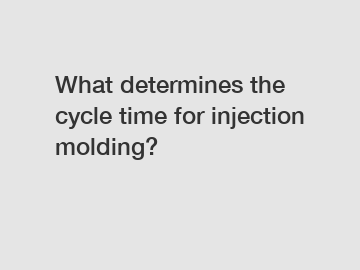What determines the cycle time for injection molding?
What determines the cycle time for injection molding?
Injection molding is a widely used manufacturing process that allows for the production of precise and complex plastic parts. To achieve optimum productivity and efficiency, it is crucial to understand the factors that determine the cycle time for injection molding. In this article, we will explore various points about injection molding cycle time and delve into the key aspects that influence it.
1. Part design complexity:

The complexity of the part being molded plays a significant role in determining the cycle time. Intricate designs with multiple features or thin walls usually require more time for cooling and solidification. On the other hand, simpler parts with uniform thickness can be molded faster. It is essential to strike the right balance between design complexity and production efficiency.
2. Material selection:
The choice of material for injection molding affects the cycle time. Different polymers have distinct thermal and flow properties, which directly impact the cooling time. Some materials require longer cooling periods to achieve sufficient strength and dimensional stability. Additionally, specific materials may have higher melt temperatures, necessitating longer cooling times. Manufacturers must carefully select the material based on the desired properties and production requirements to optimize cycle time.
3. Wall thickness:
The thickness of the molded part's walls significantly influences the cycle time. Thicker walls take longer to cool and solidify, thereby increasing the cycle time. Conversely, thinner walls reduce the cooling time, enabling faster production. However, maintaining uniform wall thickness throughout the part is essential to avoid inconsistencies and potential defects. Careful consideration of the required structural integrity and component functionality is necessary when determining the wall thickness to balance cycle time and part quality.
4. Mold temperature control:
Proper temperature control of the mold is crucial for optimizing cycle time. The cooling phase significantly contributes to the overall time required for molding. Mold temperature can be regulated through cooling channels integrated within the mold. Efficient cooling channels and temperature control systems ensure uniform heat extraction from the molten plastic, enabling faster cooling and shorter cycle times. Advanced technologies such as conformal cooling can further enhance heat transfer and minimize cycle time.
5. Injection speed and pressure:
The injection speed and pressure during the molding process affect the cycle time. Higher injection speed and pressure can help fill the mold cavity faster, reducing the cycle time. However, excessive injection speed might lead to part defects, such as air traps or insufficient packing, while high injection pressure may cause stress, warping, or sink marks. Finding the right balance between filling the mold quickly and maintaining part quality is critical for optimizing the cycle time.
6. Machine capabilities:
The machine used for injection molding significantly impacts the cycle time. Factors such as the clamping force, injection pressure, and cooling capabilities vary across different machines. Machines with higher clamping forces can accommodate larger molds and higher volumes of materials, enabling faster production. Advanced machines equipped with efficient cooling systems and precise control features can reduce overall cycle time. Regular maintenance and calibration of the machine are also essential to ensure consistent and efficient performance.
In conclusion, several factors determine the cycle time for injection molding. Part design complexity, material selection, wall thickness, mold temperature control, injection speed and pressure, and machine capabilities all play crucial roles in optimizing the overall efficiency of the process. Manufacturers must carefully evaluate these factors to strike the right balance between cycle time, part quality, and productivity. By understanding and addressing these key aspects, manufacturers can enhance their injection molding operations and drive successful production outcomes.
If you want to learn more, please visit our website wintech ltd, china airplane parts rapid mold tools manufacturer, quick turn cnc machining.


